AMD Phenom II X4 980 Black Edition Review
by Anand Lal Shimpi on May 2, 2011 10:42 PM ESTAMD has hardly kept quiet on the CPU front these past several months. At the beginning of the year AMD put the nail in Atom's netbook coffin with the Brazos platform, and last month it announced the first shipments of Llano APUs to OEMs. Expect an official launch of Llano to follow sometime in the next two months.
AMD's focus on the mainstream echoes to a certain extent its GPU strategy: focus on the bulk of the customers first, then address the smaller high end of the market. Despite an overly controlling stance on overclocking and issues with B2 stepping 6-series chipsets, Intel's Sandy Bridge (Core ix-2xxx) dominates the high end. AMD will make a go for that market later this year with its Bulldozer architecture. It's still too early for an accurate preview of Bulldozer performance, although the time for such a thing is quickly approaching.
Until Bulldozer's unveiling, the Phenom II remains as AMD's high end platform. Today, that very platform gets a little boost.
The Phenom II X4 980 Black Edition release marks a speed bump and a price drop for the quad-core Phenom II family. The 980 assumes the $195 price point, with everything else stepping down a notch in pricing:
| CPU Specification Comparison | ||||||||
| Processor | Clock Speed | Max Turbo | L2 Cache | L3 Cache | TDP | Price | ||
| AMD Phenom II X6 1100T | 3.3GHz | 3.7GHz | 3MB | 6MB | 125W | $239 | ||
| AMD Phenom II X6 1090T | 3.2GHz | 3.6GHz | 3MB | 6MB | 125W | $205 | ||
| AMD Phenom II X6 1075T | 3.0GHz | 3.5GHz | 3MB | 6MB | 125W | $195 | ||
| AMD Phenom II X6 1065T | 2.9GHz | 3.4GHz | 3MB | 6MB | 125W | $185 | ||
| AMD Phenom II X6 1055T | 2.8GHz | 3.3GHz | 3MB | 6MB | 125W | $175 | ||
| AMD Phenom II X4 980 BE | 3.7GHz | N/A | 2MB | 6MB | 125W | $185 | ||
| AMD Phenom II X4 975 BE | 3.6GHz | N/A | 2MB | 6MB | 125W | $175 | ||
| AMD Phenom II X4 970 BE | 3.5GHz | N/A | 2MB | 6MB | 125W | $155 | ||
| AMD Phenom II X4 965 BE | 3.4GHz | N/A | 2MB | 6MB | 125W | $135 | ||
Architecturally there are no surprises here. The 980 comes with a 6MB L3 cache shared by all of its cores and 512KB private L2s per core. The chip is built on Global Foundries' 45nm process with a 258mm^2 die size and around 758M transistors. TDP remains at 125W and the chip should work in all Socket-AM3 motherboards.
Don't expect any performance surprises here. The 980's closest competitor is Intel's Core i5 2400 a four core, four thread offering clocked at 3.1GHz by default with a 3.4GHz max turbo. Single threaded performance is clearly a win for the Core i5 2400:

Multithreaded performance ranges from equal between the two:
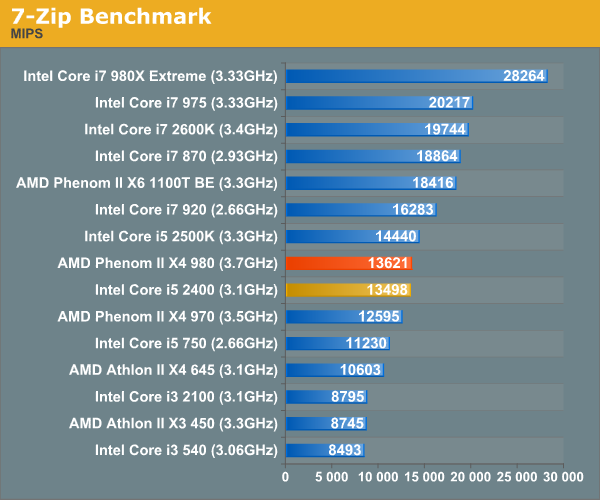
...to another win for the Core i5 2400:
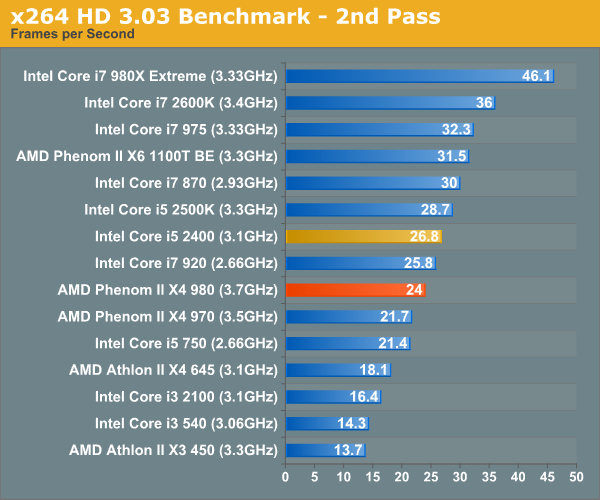
Typically the Core i5 2400 wins across the board. Load power consumption is also an advantage:
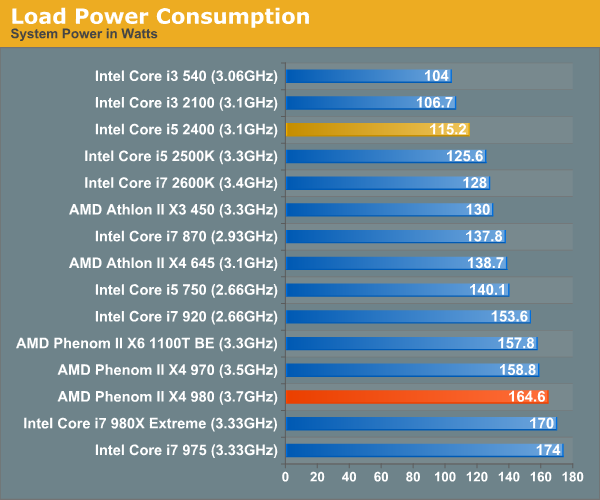
The only advantage AMD offers is a fully unlocked CPU that can be overclocked as far as physics will allow. On our sample that meant 4.2GHz with the stock cooler. Given enough voltage hitting 4GHz+ on air isn't a problem:
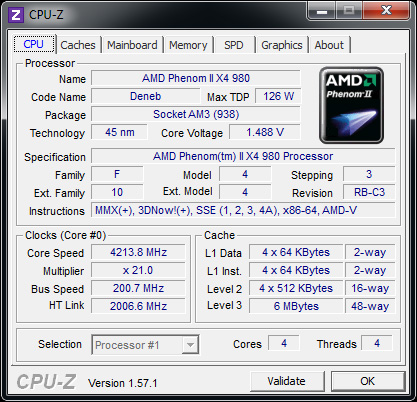
Unfortunately even while overclocked the Phenom II X4 980 can't muster enough performance to put a stock Core i5 2400 to shame:
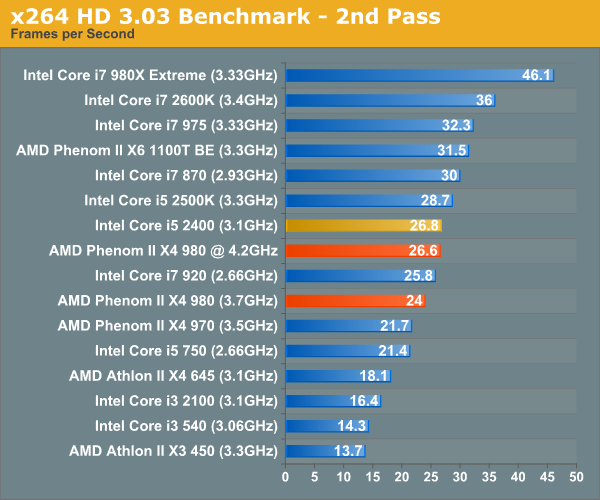
At 4.2GHz the 980 is fast enough to equal the 2400 in our x264 test and perhaps slightly surpass it in a benchmark that favors AMD's Phenom II architecture. But for the most part, even overclocked, the Phenom II X4 980 won't be worth it over Sandy Bridge.




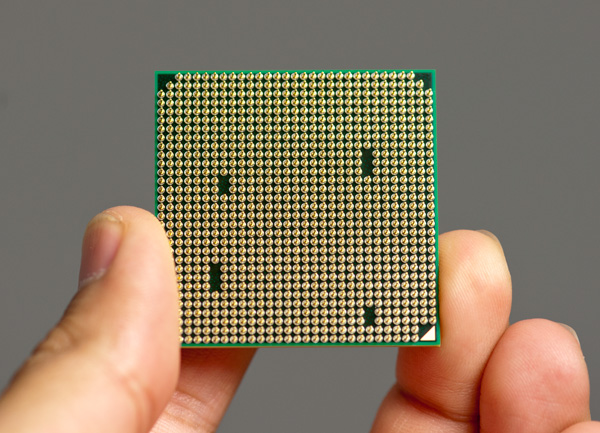








78 Comments
View All Comments
rfle500 - Tuesday, May 3, 2011 - link
I'm glad to see a compile test in the lineup. Can I ask - how did you choose number of threads for the test - was it the same for all (12) or based on number of physical, or hyperthreaded cores. In my experience, on AMD chips most compilations are faster with overloaded threads, say 2x number of physical cores - did you test this possibility?silverblue - Thursday, May 5, 2011 - link
Some programs don't work well with non-power-of-2 architectures either, which would harm performance of the X3 and X6 processors (Windows Media Encoder 9), or even worse, cripple things completely (DivX or XviD on VirtualDub uses just one of an X3's cores, so you need to set the affinity to two cores). I suppose logically, overstressing a hyperthreaded CPU would mean that the its execution units are fully utilised and, as such, logical cores won't actually make any difference, so it would be in these situations where the X6 could perhaps close the gap a little.Shadowmaster625 - Tuesday, May 3, 2011 - link
It also gives them an opportunity to remove millions of wasted cpu cycles.krumme - Tuesday, May 3, 2011 - link
Man this is some boring news. I would prefer to get some more inside or backgroud info from AMD, Intel or Arm country, even if it takes years compared to this. But i guess this is better business :)greenguy - Tuesday, May 3, 2011 - link
I keep checking here looking for the inevitable Llano review, but it's not here yet. How long do we have to wait?Action_Parsnip - Tuesday, May 3, 2011 - link
It appears you would like to marry Francois Piednoel?jabber - Wednesday, May 4, 2011 - link
Who is Francois Pedofile?Never heard of him.
529th - Tuesday, May 3, 2011 - link
I don't see this mentioned in the review nor the benchmarks, someone correct me if I am wrong but when those benches are made, are they made with Turbo disabled? If not, I don't see it as a fair comparison if you are running stock speeds when comparing a 3.3Ghz i7 2500K vs a 3.33Ghz i7 975 You have games that make use of all cores, and some that use only a few.. so you may get a higher turbo on a Sandy Bridge chip. This is not exact science but making the GHz speed into an exact comparison without Turbo enabled gives a little more insight into the product..just sayin
PubFiction - Tuesday, May 3, 2011 - link
This is just a final release to cap off Phenom 2 they know they were beat they are just giving a little speed boost to it for more value. If this was bulldozer then ya it would be bad but we already know what phenom 2 has to offer why is there so much discussion around a final revision chip. They are just throwing out what may be the most speed they can with that core until BD arrives.Casper42 - Wednesday, May 4, 2011 - link
"AMD originally introduced the Phenom II architecture over two years ago to compete with Intel's Core 2 lineup. Intel has since been through one major microarchitecture revision (Sandy Bridge) and Phenom II is beginning to show its age."Am I missing something or just not counting properly.
Phenom II introduced to compete with Core 2
Intel then Introduces Nehalem/Westmere
Intel then Introduces Sandy Bridge
So wouldn't Intel have been through 2 major architecture revisions?